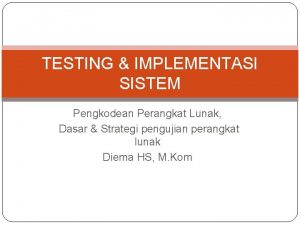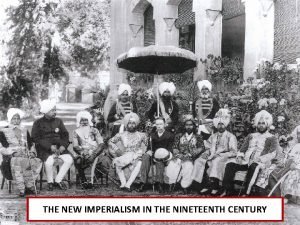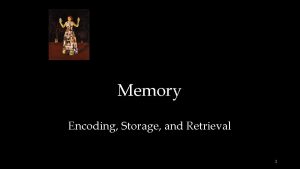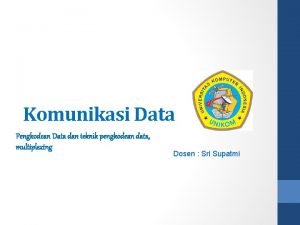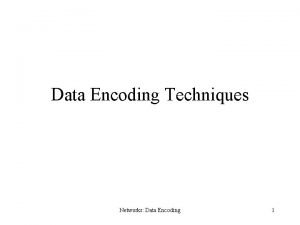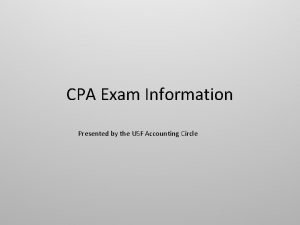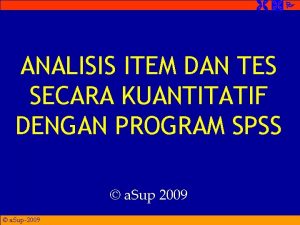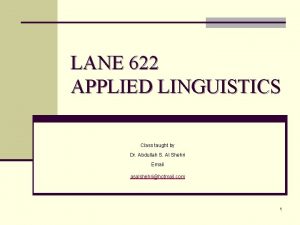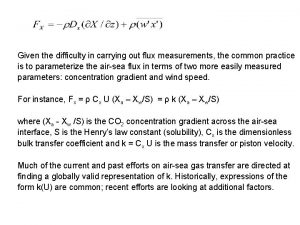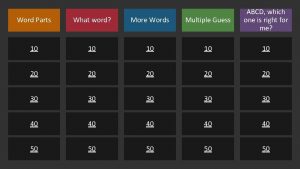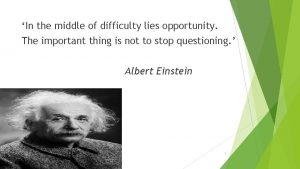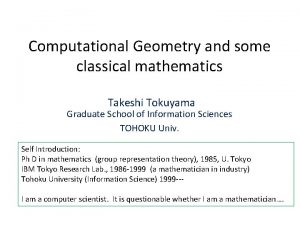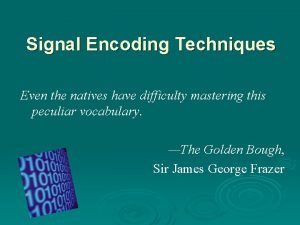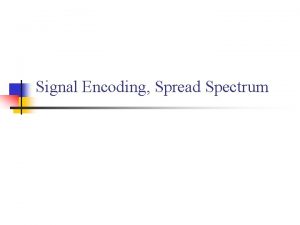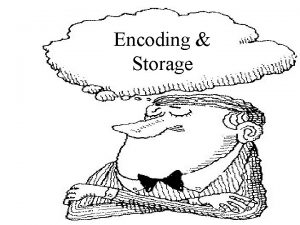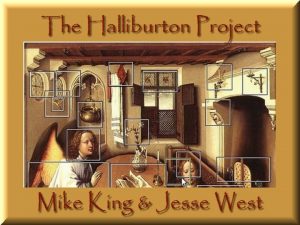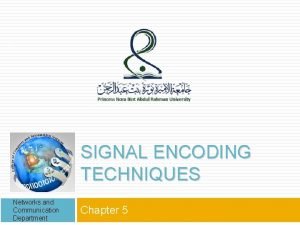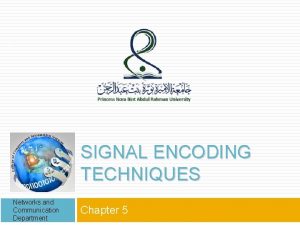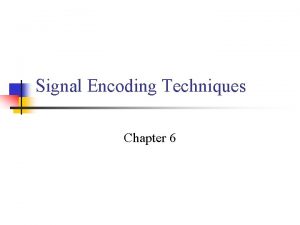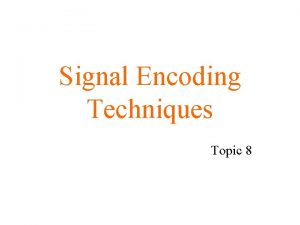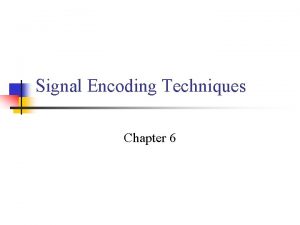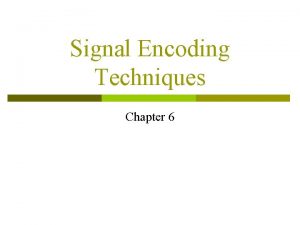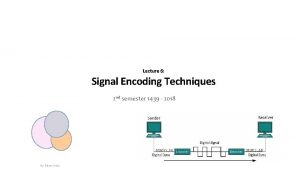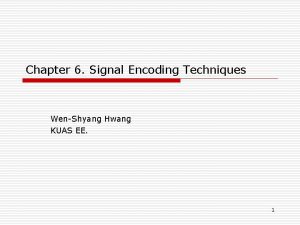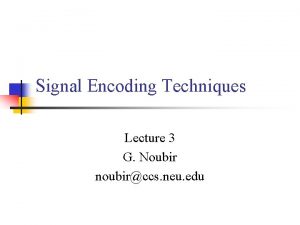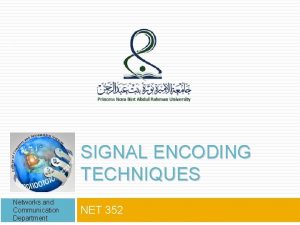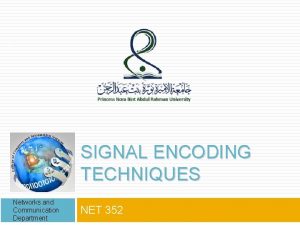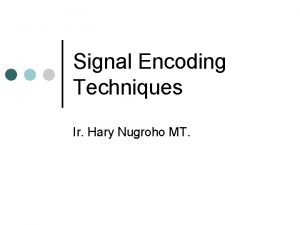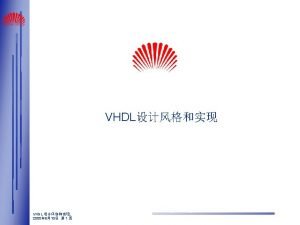Signal Encoding Techniques Even the natives have difficulty













































- Slides: 45

Signal Encoding Techniques Even the natives have difficulty mastering this peculiar vocabulary —The Golden Bough, Sir James George Frazer

Signal Encoding Techniques

Digital Data, Digital Signal Ø Digital signal l discrete, discontinuous voltage pulses each pulse is a signal element binary data encoded into signal elements

Some Terms Ø unipolar Ø data rate Ø duration or length of a bit Ø modulation rate Ø mark and space

Interpreting Signals Ø need to know l l timing of bits - when they start and end signal levels Ø factors affecting signal interpretation l l signal to noise ratio data rate bandwidth encoding scheme

Comparison of Encoding Schemes Ø signal spectrum Ø clocking Ø error detection Ø signal interference and noise immunity Ø cost and complexity

Encoding Schemes

Nonreturn to Zero-Level (NRZ-L) Ø two different voltages for 0 and 1 bits Ø voltage constant during bit interval l no transition I. e. no return to zero voltage such as absence of voltage for zero, constant positive voltage for one more often, negative voltage for one value and positive for the other

Nonreturn to Zero Inverted nonreturn to zero inverted on ones Ø constant voltage pulse for duration of bit Ø data encoded as presence or absence of signal transition at beginning of bit time Ø l l Ø transition (low to high or high to low) denotes binary 1 no transition denotes binary 0 example of differential encoding since have l l l data represented by changes rather than levels more reliable detection of transition rather than level easy to lose sense of polarity

NRZ Pros & Cons Ø Pros l l easy to engineer make good use of bandwidth Ø Cons l l dc component lack of synchronization capability Ø used for magnetic recording Ø not often used for signal transmission

Multilevel Binary Bipolar-AMI Ø Use more than two levels Ø Bipolar-AMI l l l l zero represented by no line signal one represented by positive or negative pulse one pulses alternate in polarity no loss of sync if a long string of ones long runs of zeros still a problem no net dc component lower bandwidth easy error detection

Multilevel Binary Pseudoternary Ø one represented by absence of line signal Ø zero represented by alternating positive and negative Ø no advantage or disadvantage over bipolar -AMI Ø each used in some applications

Multilevel Binary Issues Ø synchronization with long runs of 0’s or 1’s l l Ø can insert additional bits, cf ISDN scramble data (later) not as efficient as NRZ l each signal element only represents one bit • receiver distinguishes between three levels: +A, -A, 0 l l a 3 level system could represent log 23 = 1. 58 bits requires approx. 3 d. B more signal power for same probability of bit error

Manchester Encoding has transition in middle of each bit period Ø transition serves as clock and data Ø low to high represents one Ø high to low represents zero Ø used by IEEE 802. Ø

Differential Manchester Encoding midbit transition is clocking only Ø transition at start of bit period representing 0 Ø no transition at start of bit period representing 1 Ø l Ø this is a differential encoding scheme used by IEEE 802. 5

Biphase Pros and Cons Ø Con l l l Ø at least one transition per bit time and possibly two maximum modulation rate is twice NRZ requires more bandwidth Pros l l l synchronization on mid bit transition (self clocking) has no dc component has error detection

Modulation Rate

Scrambling use scrambling to replace sequences that would produce constant voltage Ø these filling sequences must Ø l l l Ø produce enough transitions to sync be recognized by receiver & replaced with original be same length as original design goals l l have no dc component have no long sequences of zero level line signal have no reduction in data rate give error detection capability

B 8 ZS and HDB 3

Digital Data, Analog Signal Ø main use is public telephone system l l has freq range of 300 Hz to 3400 Hz use modem (modulator-demodulator) Ø encoding techniques l l l Amplitude shift keying (ASK) Frequency shift keying (FSK) Phase shift keying (PK)

Modulation Techniques

Amplitude Shift Keying Ø encode 0/1 by different carrier amplitudes l usually have one amplitude zero Ø susceptible to sudden gain changes Ø inefficient Ø used for l l up to 1200 bps on voice grade lines very high speeds over optical fiber

Binary Frequency Shift Keying most common is binary FSK (BFSK) Ø two binary values represented by two different frequencies (near carrier) Ø less susceptible to error than ASK Ø used for Ø l l l up to 1200 bps on voice grade lines high frequency radio even higher frequency on LANs using co-ax

Multiple FSK Ø each signalling element represents more than one bit Ø more than two frequencies used Ø more bandwidth efficient Ø more prone to error

Phase Shift Keying Ø phase of carrier signal is shifted to represent data Ø binary PSK l two phases represent two binary digits Ø differential PSK l phase shifted relative to previous transmission rather than some reference signal

Quadrature PSK Ø get more efficient use if each signal element represents more than one bit l l l eg. shifts of /2 (90 o) each element represents two bits split input data stream in two & modulate onto carrier & phase shifted carrier Ø can use 8 phase angles & more than one amplitude l 9600 bps modem uses 12 angles, four of which have two amplitudes

QPSK and OQPSK Modulators

Performance of Digital to Analog Modulation Schemes Ø bandwidth l l ASK/PSK bandwidth directly relates to bit rate multilevel PSK gives significant improvements Ø in presence of noise: l l bit error rate of PSK and QPSK are about 3 d. B superior to ASK and FSK for MFSK & MPSK have tradeoff between bandwidth efficiency and error performance

Quadrature Amplitude Modulation QAM used on asymmetric digital subscriber line (ADSL) and some wireless Ø combination of ASK and PSK Ø logical extension of QPSK Ø send two different signals simultaneously on same carrier frequency Ø l l use two copies of carrier, one shifted 90° each carrier is ASK modulated two independent signals over same medium demodulate and combine for original binary output

QAM Modulator

QAM Variants Ø two level ASK l l l each of two streams in one of two states four state system essentially QPSK Ø four level ASK l combined stream in one of 16 states Ø have 64 and 256 state systems Ø improved data rate for given bandwidth l but increased potential error rate

Analog Data, Digital Signal Ø digitization is conversion of analog data into digital data which can then: l l l be transmitted using NRZ-L be transmitted using code other than NRZ-L be converted to analog signal Ø analog to digital conversion done using a codec l l pulse code modulation delta modulation

Digitizing Analog Data

Pulse Code Modulation (PCM) Ø sampling theorem: l l “If a signal is sampled at regular intervals at a rate higher than twice the highest signal frequency, the samples contain all information in original signal” eg. 4000 Hz voice data, requires 8000 sample per sec Ø strictly have analog samples l Pulse Amplitude Modulation (PAM) Ø so assign each a digital value

PCM Example

PCM Block Diagram

Non-Linear Coding

Companding

Delta Modulation Ø analog input is approximated by a staircase function l can move up or down one level ( ) at each sample interval Ø has binary behavior l l l since function only moves up or down at each sample interval hence can encode each sample as single bit 1 for up or 0 for down

Delta Modulation Example

Delta Modulation Operation

PCM verses Delta Modulation Ø DM has simplicity compared to PCM Ø but has worse SNR Ø issue of bandwidth used l eg. for good voice reproduction with PCM • want 128 levels (7 bit) & voice bandwidth 4 khz • need 8000 x 7 = 56 kbps Ø data compression can improve on this Ø still growing demand for digital signals l use of repeaters, TDM, efficient switching Ø PCM preferred to DM for analog signals

Analog Data, Analog Signals modulate carrier frequency with analog data Ø why modulate analog signals? Ø l l Ø higher frequency can give more efficient transmission permits frequency division multiplexing (chapter 8) types of modulation l l l Amplitude Frequency Phase

Analog Modulation Techniques Amplitude Modulation Ø Frequency Modulation Ø Phase Modulation Ø

Summary Ø looked at signal encoding techniques l l digital data, digital signal analog data, digital signal digital data, analog signal analog data, analog signal
 Signal encoding techniques in data communication
Signal encoding techniques in data communication What is the product of an even signal and odd signal?
What is the product of an even signal and odd signal? Hardware or software encoding
Hardware or software encoding Natives of new zealand
Natives of new zealand Jacques cartier route
Jacques cartier route The natives
The natives Memory encoding techniques
Memory encoding techniques Jenis jenis pengkodean data
Jenis jenis pengkodean data Data encoding techniques
Data encoding techniques Regular expression of even even language
Regular expression of even even language Regular expression of even even language
Regular expression of even even language Baseband signal and bandpass signal
Baseband signal and bandpass signal Baseband signal and bandpass signal
Baseband signal and bandpass signal Digital signal as a composite analog signal
Digital signal as a composite analog signal Which shape has 6 faces 12 edges and 8 vertices
Which shape has 6 faces 12 edges and 8 vertices @_______shart_______:https://youtu.be/wksin3y8b78
@_______shart_______:https://youtu.be/wksin3y8b78 Generally restful like the horizon where the sky
Generally restful like the horizon where the sky Generally restful like the horizon where the sky meets land
Generally restful like the horizon where the sky meets land Generally restful like the
Generally restful like the Virtual teams are often slowed down by difficulty with
Virtual teams are often slowed down by difficulty with Specific learning difficulty
Specific learning difficulty Cpa exam difficulty ranking
Cpa exam difficulty ranking Item difficulty adalah
Item difficulty adalah Difficulty in emotion regulation scale
Difficulty in emotion regulation scale Prator's hierarchy of difficulty
Prator's hierarchy of difficulty Flux difficulty
Flux difficulty _____ is difficulty in starting a urinary stream.
_____ is difficulty in starting a urinary stream. Nba schedule strength
Nba schedule strength In the middle of every difficulty lies opportunity
In the middle of every difficulty lies opportunity Uuuu0
Uuuu0 Himss certification
Himss certification Area of difficulty
Area of difficulty Taboo game card color difficulty
Taboo game card color difficulty Casp difficulty
Casp difficulty Difficulty continuum
Difficulty continuum Fonctions techniques et solutions techniques
Fonctions techniques et solutions techniques Hát kết hợp bộ gõ cơ thể
Hát kết hợp bộ gõ cơ thể Ng-html
Ng-html Bổ thể
Bổ thể Tỉ lệ cơ thể trẻ em
Tỉ lệ cơ thể trẻ em Chó sói
Chó sói Thang điểm glasgow
Thang điểm glasgow Bài hát chúa yêu trần thế alleluia
Bài hát chúa yêu trần thế alleluia Môn thể thao bắt đầu bằng từ đua
Môn thể thao bắt đầu bằng từ đua Thế nào là hệ số cao nhất
Thế nào là hệ số cao nhất Các châu lục và đại dương trên thế giới
Các châu lục và đại dương trên thế giới


